Phillip Adams: Into the Wild
By: Matt Hardman, Seraphin Gallery Resident
Nestled within the isolated and frozen mountaintops of Europe, you come across a ferris wheel, a plastic dining table, playground toys, and an assembly of pink flamingos. Phillip Adams’ Matterhorn series, illustrates the vast and cold landscape of the Swiss Alps littered with light-hearted and bright artificial decor and amusements. Inspired by the Disneyland attraction, which takes the dangerous, real-life location down to size and turns it into a theme ride, Adams comments on humanity’s tendency to impose ourselves onto nature. By shrinking the Matterhorn down in scale, we exhibit a level of control over the environment. This frigid and lifeless landscape loses its power and the fear it instills in us when it is broken down and treated as an object of enjoyment. Even in his mediums, Adams reiterates the dichotomy of the natural and artificial by using charcoal for his mountain ranges and oils for his plastic, man-made objects.
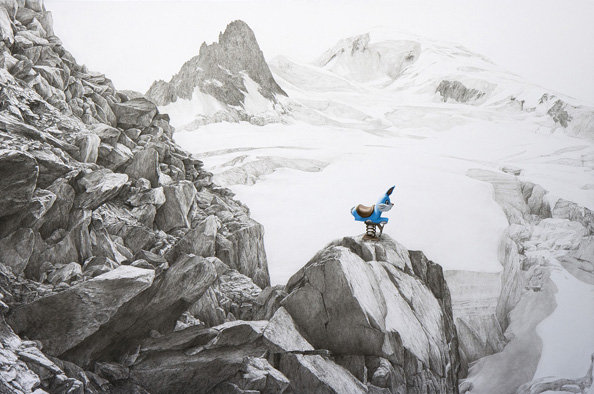 Phillip Adams, The Hunt, 2013, Charcoal, graphite, and oil on panel, 36" x 24".
Phillip Adams, The Hunt, 2013, Charcoal, graphite, and oil on panel, 36" x 24".
In The Hunt (fig. 1), Adams presents a children’s playground toy amidst a cragged and unforgiving environment. This transforms the landscape into one that is both playful and absurd. Along with placing an amusement object onto the natural world, the object itself is a plastic, blue rabbit. Another element in nature is being transformed, simplified, and commodified for human enjoyment. The title suggests that something is hunting and being hunted. The rabbit, a prey animal, is the object of the viewers’ hunt, but hunt for what exactly? The artificial animal cannot be eaten, but can be consumed and used as an object. This idea of consumption is crucial in humanity’s assertion over the natural world.
Adams’ Flamingos (fig. 2) depicts a mountain range decorated with a flock of lawn ornaments. The pink, plastic flamingo is a symbol of domestic living. Divorced from the bird itself, this object is so commonplace that it exist nearly without reference to the animal it represents. The flamingos are scattered throughout the landscape, arranged in a way that mimics live animals, wandering through their environment. The concept of lawns and land ownership is prevalent throughout this piece, commenting on the absurdity of parsing up the Earth into easily controlled plots. Plastic flamingos, although the typical in neighborhood habitats, are comical in the natural environment of the Alps.
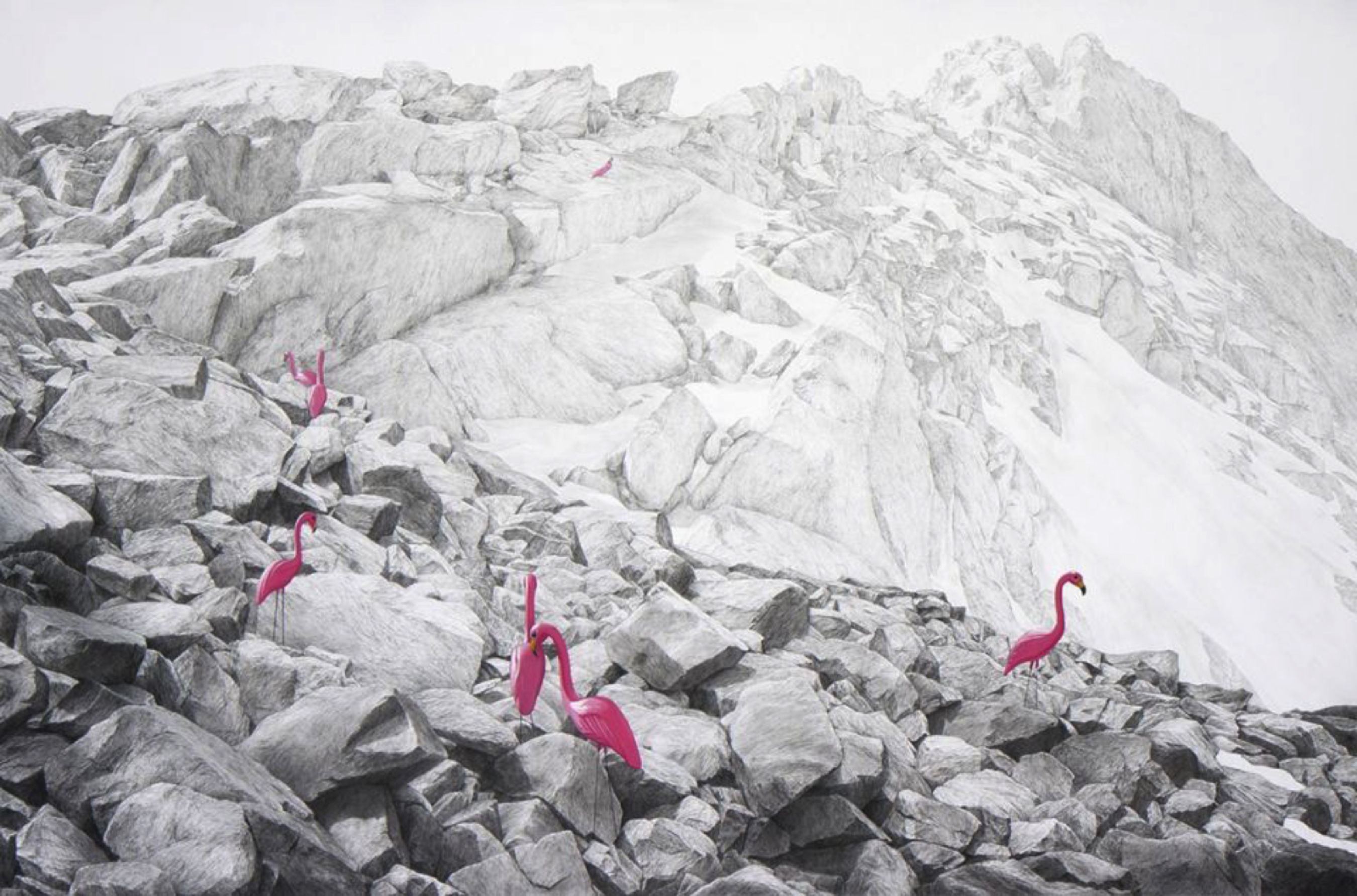 Phillip Adams, Flamingos, 2014, Charcoal and oil on panel,
Phillip Adams, Flamingos, 2014, Charcoal and oil on panel,
Phillip Adams is a Philadelphia based artist. He completed his BFA at the University of Georgia and his MFA at the University of Pennsylvania. Adams’s work has been exhibited at Seraphin Gallery, Arcadia University, Moore College of Art, The University of Pennsylvania, Institute of Contemporary Art, Philadelphia Museum of Art, Tiger Strikes Asteroid (co-founder), and Bridgette Mayer Gallery. He has produced several pieces of public art, including murals throughout the Philadelphia area as well as in Montreal.
Adams has recently completed his second mural in his “Industrious Light” series at Rowhouse Spirits Distillery through the City of Philadelphia Mural Arts Program and Hidden City Philadelphia. Adams has produced a 27,000 square-feet mural in collaboration with the Philadelphia Eagles and this fall he plans on finishing his third mural in the “Industrious Light” series. Seraphin Gallery congratulates Phillip Adams on his recent success and is pleased to present an upcoming solo show, opening April 22nd, 2016.
A Note From Seraphin Gallery: Madeline Peckenpaugh
We are pleased you are interested in our youngest and most recent painter, Madeline Peckenpaugh. We believe that she has reinvigorated the legacy left behind by Jackson Pollock and Jasper Johns. These blue chip mid-twentieth century artists changed the face of the fine art forever. The all-over style, defined by Clement Greenberg as a composition which could be expanded beyond the canvas, and action painting, coined by Harold Rosenberg, detached art from social or ethic normality and seduced viewers in one instant.
Madeline Peckenpaugh denies the connection to the all-over painting style, but acknowledges that she is akin to the action painters of the 1950s. Large gestures of movement during her painting process is crucial. She enjoys working the canvas to its limits, through sculpting paint in relief. She diverges from the all-over technique because of her careful planning of the composition. Although it may appear that Peckenpaugh is painting crudely, her work is defined by creating paths and blockades throughout the painting.
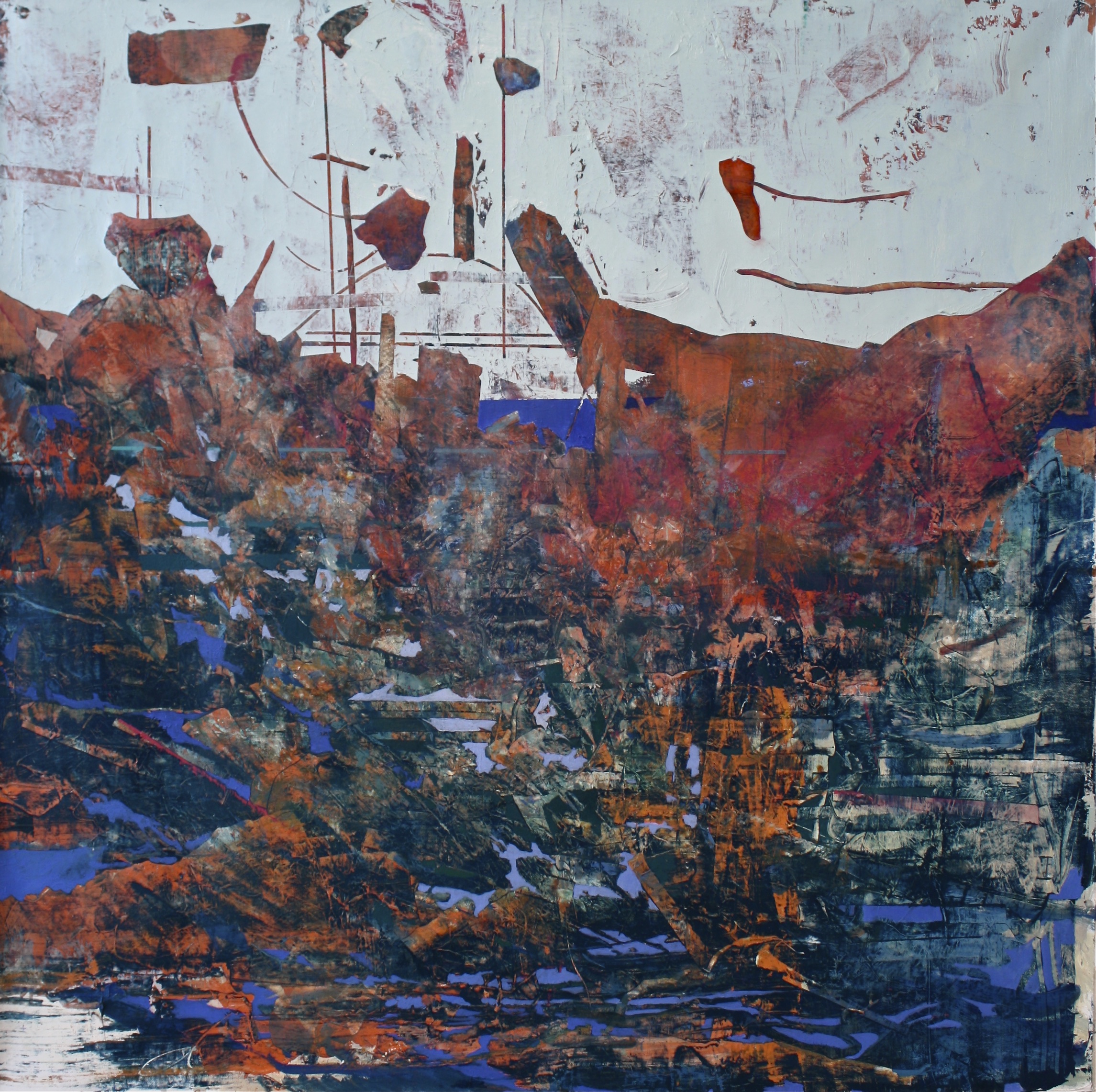 Madeline Peckenpaugh, January 27, 2014, Oil on canvas, 42" x 44.5"
Madeline Peckenpaugh, January 27, 2014, Oil on canvas, 42" x 44.5"
Peckenpaugh creates these paintings and hangs them low to the ground to simulate an entryway. The artist encourages the viewer to feel as though they could walk into her paintings - that she has created a space for them, but there is a struggle. This notion of real space sets Peckenpaugh apart from the work of the Abstract Expressionists-- whose work was meant to be felt in one overpowering instant. Seraphin Gallery has coined Peckenpaugh as an Abstract Realist. This term oxymoronically describes the unique and profound conflict that viewers deal with when presented with her work, adding another dimension to this promising Philadelphia artist.
The inspiration for her work starts as a feeling, something intangible. This emotion is based upon surroundings, ambience, the weather-- one instant of awareness. She then recreates this sensitivity in a painting. The depth in her painting is deceitful, she allows multiple entry points for the viewer's eye and then closes them off. This is not to betray the viewer, but to translate perceptions, whether they be pleasure, anxiety, comfort, excitement, or immobilization.
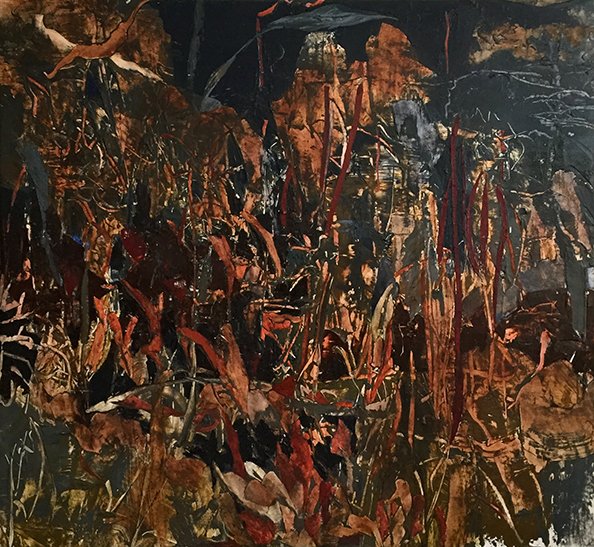 Madeline Peckenpaugh, 5-17-15, 2015, Oil on paper, 13.5" x 12.5"
Madeline Peckenpaugh, 5-17-15, 2015, Oil on paper, 13.5" x 12.5"
She is a graduate of both the Certificate and Bachelors of Fine Arts programs of the Pennsylvania Academy of the Fine Arts. Founded in 1805 by Charles Wilson Peale, the Academy is modeled after the French Academies, focusing on representing the human form through rigorous training and study. Peckenpaugh's paintings are consummated with a trained eye from the oldest and one of the most respected art schools in the nation.
The artist carefully prescribes a rich color palette, which commands respect in any collection. These paintings are brilliant, both in skill and while her works are large, she has graciously accepted our request, on behalf of collectors, to create commissioned works on a slightly smaller scale so her painting is more easily accessible.
Art Has Value
By: Alyssa Laverda, Assistant to the Directors and Head of Sales, with Research by Megan Nicoletti, Intern
Art has value. Art is not just an abstract concept in which we can experience visual and emotional pleasure-- there is a monetary factor involved. For centuries, art has been among prized possessions and also an established investment. In today’s society, consumers and investors are more interested in watching the Nasdaq counter, displaying faith in companies as opposed to works of art that can accrue just as efficiently and more safely than gambling on a startup. Arthena is the world’s first crowdfunding investment platform for those seeking a new way to invest in art assets. Their study on investment in Post War (after 1945) and Contemporary works in correlation with the S&P 500 indicates the statistics of how investing in contemporary art over the years has been significantly more successful.
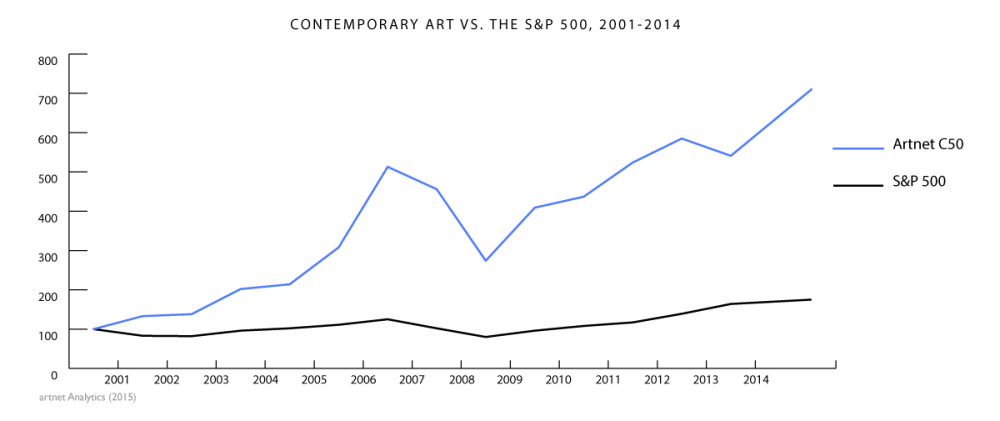 Photo Courtesy of Arthena Inc.
Photo Courtesy of Arthena Inc.
With over 45 years of specializing in contemporary art and art consulting, Seraphin Gallery has a growing range of collectors investing in active artists who are part of public collections all over the nation. Seraphin Gallery has had success with increasing the value and sales of their artist’s work. With almost half a century of expertise, Seraphin Gallery has artists that have been shown in institutions such as The Guggenheim, The Brooklyn Museum of Art and The Philadelphia Museum of Art. We specialize in tailored consulting that dispenses great appreciation towards each piece selected. Tony Seraphin, the Director, states “Every square inch of your walls is your vault, use it wisely”. Seraphin Gallery helps collectors make personal and professional decisions that result in a profound acquirement.
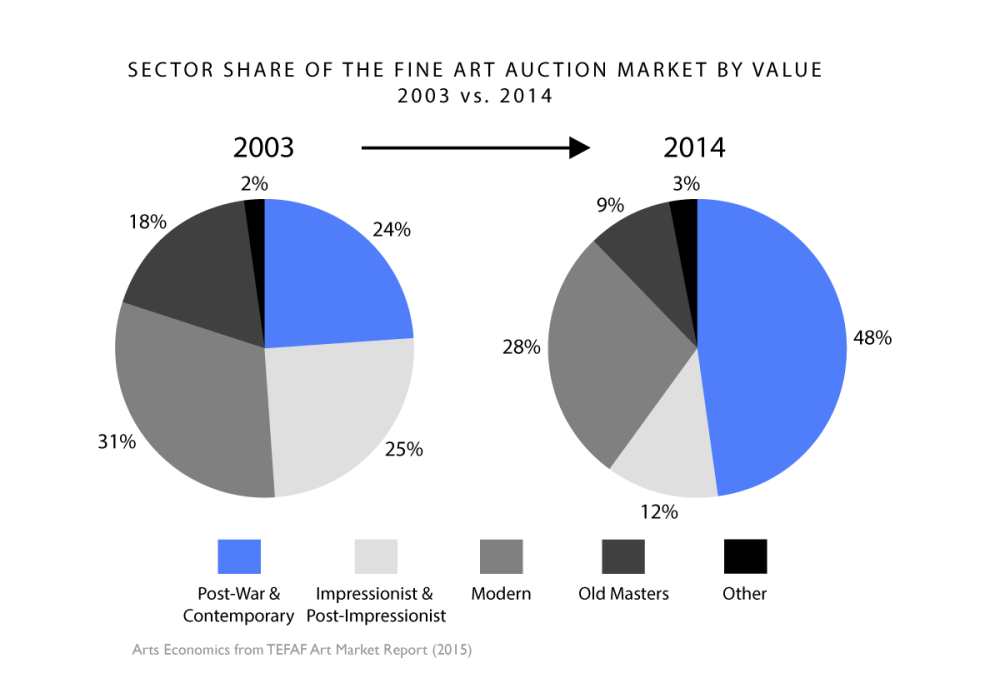 Photo Courtesy of Arthena Inc.
Photo Courtesy of Arthena Inc.Throughout an artist’s career the value of their work can increase. When an artist has an exhibition or show affiliated with a public institution this can raise the reputation of the artist and their work. Seraphin Gallery extensively promotes their artists to major institutions and establishments nationwide by setting up acquisitions, traveling exhibitions, and shows in other regions. For example, Seraphin Gallery is currently representing Victor Vazquez, who will be having a major retrospective at the Museo de Arte de Puerto Rico in the Fall of 2016. This recognition can lead to a gain for collectors who have already invested in Vazquez. We welcome new collectors to our base every week. We are passionate about guiding and assisting our clientele in finding investments that are individual and exclusive for each collector.
Elissa Marian Tuerk
By Megan Nicoletti, Intern
Elissa Marian Tuerk is an artist located in Philadelphia, Pennsylvania, currently working in the mediums of sculpture, photography and digital collage. Elissa Tuerk began her college education at Delaware County Community College with a Certificate in Photography and an Associates degree in Fine Arts. Tuerk has been featured in seven exhibitions at Delaware County Community College, along with being awarded the Honorable Mention award.
Pursuing her path in the art field, Elissa Tuerk spent the rest of her college career attending Moore College of Art and Design in Philadelphia. Tuerk adding on to her success thus far received the Board of Trustees scholarship at Moore College of Art and Design which lead her to countless opportunities. In addition to being accepted into the San Francisco Disposable Film Festival, Tuerk’s artwork has been in several shows in Philadelphia such as Merge and Convergence. Wrapping up her college career, Elissa Tuerk was awarded the QVC Award for Professional Presentation and Accomplishment in Photography and Digital Art for her Moore’s Senior Thesis Exhibit.
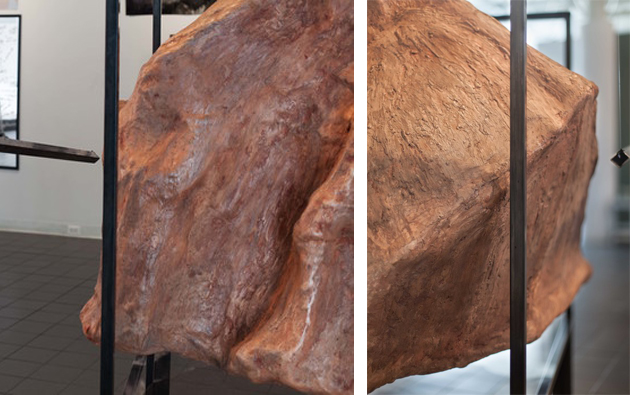 Fig 1: Elissa Marian Tuerk, Rock and Vitrine in Conflict, 2015, Plaster, pastel, graphite, and steel, 49"W x 45" D x 66" H
Fig 1: Elissa Marian Tuerk, Rock and Vitrine in Conflict, 2015, Plaster, pastel, graphite, and steel, 49"W x 45" D x 66" H
Elissa Marian Tuerk, Edge, 2014-2015, wood, steel, plaster, pastel, graphite, 59" H x 14 1/4" W x 17 1/4" D When observing Rock and Virtrine in Conflict ( see fig. 1), it portrays an image that is not what it might be. From a far distance, the surroundings seem to be holding up the rock, however, when close up to the sculpture, the rock is essentially floating in the middle. Rocks are heavy masses, and this created boulder is an illusion of a lack of gravity. Elissa Tuerk’s strategy of questioning established norms and challenging traditional forms and limits of artwork is shown in this sculpture; the rock poses a question to viewer, not only of physics through the levitation of the subject, but also an emotional one. Trapping a form of nature within a manmade structure elicits anxiety and confusion. Tuerk centers her work around her bold and wide ranged curiosity about the world. Rock and Virtrine in Conflict expresses Elissa Tuerk’s way of expressing art through illusion and fabrication. It is also a piece that portrays Tuerk’s method of inviting the viewer to question their perception of what is normal, official or accepted.
Elissa Tuerk is currently represented by Seraphin Gallery and her work is on display in Gallery 2 until October 18, 2015. Seraphin Gallery is pleased to congratulate Elissa Tuerk on her achievements thus far.
Quiet Devotion: Victor Vazquez
By: Matt Hardman, Intern with significant research by Nataliya Hines, Intern
Victor Vazquez is a photographer and multimedia artist, born in San Juan, Puerto Rico. Vazquez earned an undergraduate degree in Psychology and Sociology from the University of Puerto Rico and completed his graduate studies in Education and Comparative Religion at New York University before pursuing his career as an artist. While studying in Barcelona, student strikes prevented Vazquez from completing his academic program, but allowed him the freedom to focus on his art. He traveled to China, India, and Japan to study art, literature, and the cultural history of the regions, and began taking photographs. Vazquez’s work, both in form and concept, revolves around the human body. He utilizes the body as a vehicle to communicate both political issues and personal struggles throughout his work. Vazquez addresses the ways in which the state influences and validates social practices within a culture. He reflects on and contextualizes his cultural identity as a Puerto Rican in his art. In response to the AIDS crisis, the Humanities of Art produced Vazquez’s book “The Realm of Waiting”. The Puerto Rico Art Critic Association selected Vazquez’s work as art book of the year. La Ave Maria (see fig. 1) exemplifies Vazquez’s interest in communicating through the human form. He implements religious and ritualistic imagery, reflecting the conflicting cultures of Christianity and Santeria in Puerto Rico. The photograph depicts a nun in quiet devotion however she is nude and adorned in the body parts of chickens. The visceral imagery is in stark contrast with the more conservative Christian apparel. However both are religious objects and symbols of devotion, connecting the religious beliefs of Puerto Rico. The beauty of life, the human form, and modern culture is juxtaposed with death, wildlife, and the cultures of the past. The contrast is jarring yet soft, calling upon recognizable religious artifacts to guide the viewer towards an understanding. Vazquez plays with his cultural identity and the assumptions associated with Caribbean culture. 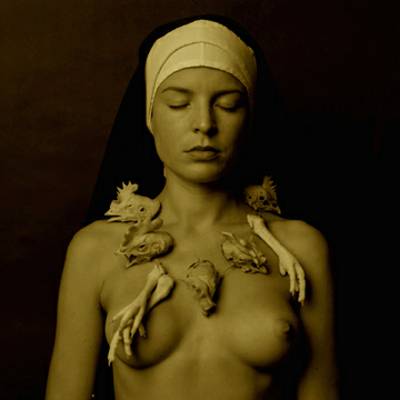 Fig. 1: Victor Vazquez, La Ave Maria (1/5) , 1996, Hand painted gelatin silver print with wax, 48" x 48".
Fig. 1: Victor Vazquez, La Ave Maria (1/5) , 1996, Hand painted gelatin silver print with wax, 48" x 48". 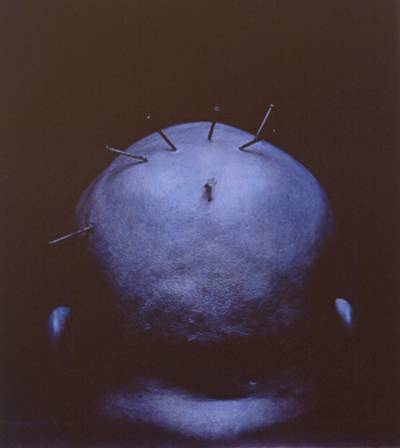 Victor Vazquez, Nail-Head, 1998, Hand painted gelatin silver print with wax, 48" x 48".
Victor Vazquez, Nail-Head, 1998, Hand painted gelatin silver print with wax, 48" x 48".

